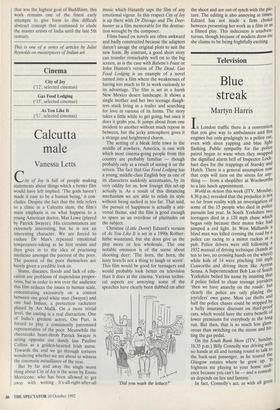Indian art
Buddha the Greek
Juliet Reynolds
0 ne of the most curious aspects of the art of Buddhist India is that it developed in violation of the Buddha's own law. Fearing that figurative images might seduce his fol- lowers from their difficult path, he had stipulated that only vegetal and geometric motifs were suitable for their contempla- tion. In the three centuries subsequent to his death, this law was evidently adhered to quite rigorously. But from the 3rd century BC, when the growing influence and wealth of the monasteries created the demand and the means for the raising of permanent stone structures at key sites along trade routes, the maintenance of such purity was no longer viable. In the absence of a pow- erful representative imagery that embodied the spirit of popular culture, Buddhism could not have succeeded as spectacularly as it did in attracting adherents from every sector of society and, through this, in con- tributing so enormously to the economic expansion of the subcontinent.
By the 1st century AD, two centres in particular had transgressed the Buddha's injunction on image-making. The first was Mathura, close to Delhi. The other was Gandhara, around the upper Indus river and in the lower Kabul valley, that had ear- lier been conquered by Cyrus of Persia and Alexander of Macedon. Both areas had long been gathering-places for unorthodox thinkers, among them dissident Buddhists of eclectic and metaphysical tendencies Who began to define the Buddha as a deity incarnate rather than as a supremely enlightened leader of the mortal, material world. As a result, the first Buddha images were created in these centres.
At about the turn of the 2nd century, fur- ther links were forged between them by the Emperor Kanishka, a devout Buddhist and enlightened patron of art and science whose forebears originated in central Asia and under whom contacts between India and China were to receive their greatest impetus. At Mathura, the name of his dynasty, Kushana, was to become immor- tally associated with a style of art evolved from largely indigenous sources, while the Patronage he extended to the workshops of Gandhara resulted in the emergence of the Greco-Roman Buddhist school that bears the name of the province.
No one is yet quite certain of the origins of Gandhara's artisans. Alexandrian and, later, Greek Bactrian rule (2nd-1st cen- turies BC) have left us little but beautiful coins as records, though it is certain that in the intervening period cultural ties between India and Greece were greatly encouraged by the Buddhist emperor, Ashoka Maurya. But in the heyday of the Gandhara work- shops under Kanishka and his successors, links with the Roman Empire were consid- erable, and so it is highly probable that some Gandhara masters hailed from Alexandria and Syria.
Contrary to the view of earlier, inevitably Eurocentric scholars, for whom the natu- ralism of Hellenic art implied superiority, the art of Gandhara was generally inferior to that of Mathura. The vitality of the latter was in large part due to the capacity of its masters to assimilate diverse influences including, via Gandhara, the Hellenic and to create from these a unique, highly expressive style. In its earlier stages, Gand- hara art tended to be crudely imitative of the Greco-Roman style and later to lapse into mannerism. Importantly, the excep-
tional works of this school embody a syn- thesis of Hellenic and Indian ideals, a natu- ralism brought to life by certain principles of stylisation evolved by Mathura's masters.
One such exception is a little-known Buddha's head, probably belonging to the late 2nd century. In style it is most appar- ently Roman, particularly in the treatment of the wavy hair, the aquiline nose and patrician lips. Its only immediately obvious departure from Hellenic naturalism is in the strangely elongated ear lobes and exag- gerated mole between the eyebrows, both according to legend attributes of the Enlightened One. Yet on closer scrutiny the Indian-ness of this image begins to strike one. The dreamy serenity of its expression is largely communicated through the tensionless arched brow and half-closed eyes that are stylised respective- ly like a crossbow and lotus petals, strongly suggesting the influence of Mathura. Though the master who carved it did not quite achieve the absolute immovability Gandhara Buddha, c. 2nd-3rd century AD, from the Chandigarh Museum that was the highest goal of Buddhism, this work remains one of the finest early attempts to give form to this difficult abstract concept that continued to elude the master artists of India until the late 5th century.
This is one of a series of articles by Juliet Reynolds on masterpieces of Indian art.



























































 Previous page
Previous page